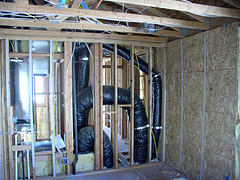Take Care of Ducts Now for Greener, Cheaper Winter Heat
 How can you prepare for a healthier, energy-efficient, and money-saving winter? Take care of your HVAC ductwork by cleaning, repairing, and insulating it as necessary. Proper attention to the air duct system is an easy, inexpensive step toward improved air quality and more efficient heating. Why not take care of this task now, before winter's cold sets in?
How can you prepare for a healthier, energy-efficient, and money-saving winter? Take care of your HVAC ductwork by cleaning, repairing, and insulating it as necessary. Proper attention to the air duct system is an easy, inexpensive step toward improved air quality and more efficient heating. Why not take care of this task now, before winter's cold sets in?
Clean
Routine vacuuming or dusting of your HVAC registers is important, but regular cleaning deep inside the ducts is not necessary. However, certain circumstances do warrant cleaning the interior of your ducts ASAP -- for your health's sake. If mold starts growing inside your HVAC ducts, it is essential to clear out the ductwork to avoid allergies, asthma, and other breathing problems.
Occasionally vermin or insects make their home inside the ductwork; have the pests removed pronto and the ducts thoroughly cleaned. During home remodeling, duct openings should be well covered. However, if large amounts of dust or any debris from lead paint or asbestos have entered the ducts, they must be cleaned urgently. Finally, if you find unpleasant odors, animal hair, or other contaminants coming into the ambient air via your ductwork -- or a household member is suffering from an unexplained respiratory illness, persistent headache, or rash -- duct cleaning is strongly advised.
NOTE: Never use a steam cleaner on your ducts; you do not want to introduce large amounts of moisture into the system. While you can clean the surface and ends of ducts yourself (use a rag lightly dampened with bleach solution), you will not be able to reach as far as a trained HVAC service person armed with a professional duct-cleaning machine.
Repair Leaks
Your duct system can leak due to either holes in individual duct pipes or poor connections between pipes. These leaks may reduce the heating and cooling ability of your HVAC by up to 20 percent, while at the same time increasing greenhouse gas emissions. Even worse, they might backdraft life-threatening gases such carbon dioxide from your furnace or other appliances into your living space.
Leaks can be difficult to find, since the ductwork runs through small hard-to-get-at areas such as crawl spaces. To track down sources of leakage, turn the HVAC thermostat to "on" instead of "automatic." This will allow you to feel for escaping hot air as well as visually inspecting the ducts.
Turn off the HVAC and apply mastic sealant, metal tape (NOT ordinary duct tape, which doesn't last long enough), or aerosol sealant to repair any leaks or faulty connections that you discover. Especially large gaps may need to be filled in with insulation before using the mastic.
Insulate
Insulation helps conserve the cool air produced by your HVAC system in summer and warm air in winter, reducing energy consumption and saving you money on utilities. It's easy to determine whether insulating your ducts is a good idea. Just evaluate the difference in temperature between the air running through your ductwork and the air around it. This tends to be particularly pronounced in northern locales when your ducts go through an uninsulated attic. For example, if your HVAC is sending air through the ducts at 68 degrees F and the surrounding area under your Chicago roof is a chilly 40 degrees or less, insulation is highly recommended.
Material for insulating ducts comes in sleeve or blanket style, with the latter being easier for a DIYer to apply. Typically, it consists of cotton, foam (use only non-flammable foam created specially for this purpose), fiberglass, or bubble wrap backed with foil as a moisture barrier. The cotton type is the most eco-friendly variety. Choose the best R-value for your locale.
Laura Firszt writes for networx.com.
Updated September 17, 2018.
Looking for a Pro? Call us (866) 441-6648

Heating & cooling Average Costs
HVAC Contractors Experiences

Heat Pump Replacement By A Contractor I Can Trust

Desperate For New Air Conditioning On A Hot, Humid July Weekend



